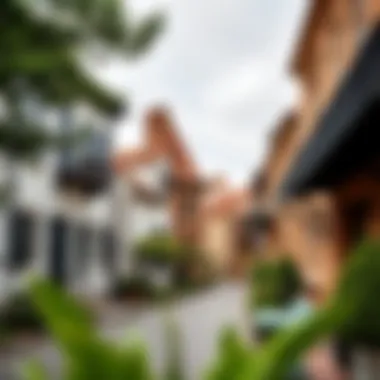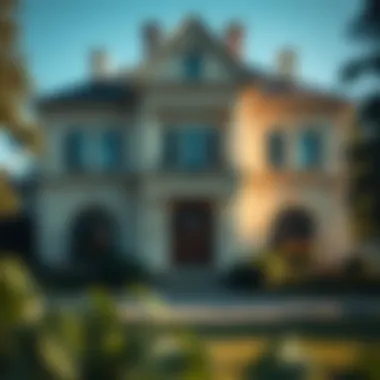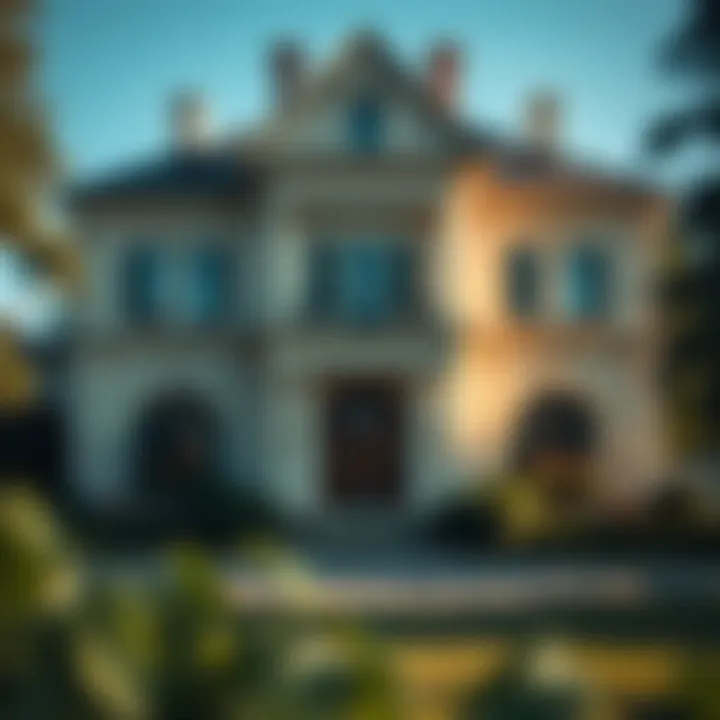The Charm of Buying Historical Homes: Insights and Tips


Intro
Historical houses hold a significant allure for many—offering not just shelter but also a tapestry of stories embedded in their very walls. In recent years, the market for such homes in Dubai has gained traction amongst savvy investors, expatriates seeking a sense of belonging, and locals who have long appreciated the architectural heritage of the city. Each house, with its unique character, offers the chance to breathe new life into history, making it an enticing option for potential buyers.
However, navigating the complexities of purchasing a historical property brings its own set of opportunities and challenges. With such a diverse audience looking at the market—from seasoned investors to first-time home buyers—understanding the nuances of these homes becomes paramount.
This article will dissect the landscape of historical houses for sale in Dubai, focusing on architectural significance, renovation challenges, and the investment potential these homes entail. As we explore the vibrant real estate scene, we will chart out not only the trends currently shaping the market but also the potential future directions it might take.
Through this examination, the goal is to provide a comprehensive guide for anyone interested in owning a piece of history.
Market Insights
Current Trends in Dubai Real Estate
Dubai's real estate market has witnessed remarkable evolution over the years. The surge in interest for historical properties can be tied to several factors:
- Cultural Appreciation: There is a growing trend amongst buyers towards valuing cultural heritage. People want to invest in properties that tell a story.
- Architectural Beauty: Many historical homes boast unique designs that modern constructions simply can’t replicate. This draws in buyers with an eye for aesthetics.
- Sustainable Living: Historical homes often utilize sustainable materials and construction methods, appealing more to environmentally conscious buyers.
Coupled with these factors, the city's broader revitalization efforts are working towards integrating its historical past with modern development, making now an opportune moment for investment.
Future Predictions and Market Analysis
Forecasts suggest that demand for historical properties in Dubai is set to grow as more expatriates and investors recognize their value. Experts predict:
- Increased Prices: As more buyers compete for unique properties, prices are likely to rise.
- More Renovations: The tempting idea of refurbishing older buildings to modern standards will drive renovation projects upwards.
- Shift in Buyer Demographics: Expect an influx of younger buyers, particularly those interested in lifestyle rather than just real estate investment.
Quote:
"Investing in historical properties not only preserves the past but also paves the way for future generations to appreciate architectural artistry."
Moreover, as Dubai positions itself as a cosmopolitan destination, the appeal of owning a historical house becomes evident, merging lifestyle with investment potential in a city that thrives on innovation.
Investment Opportunities
High-ROI Property Areas
Though historical properties can come with hefty price tags upfront, their potential for high returns on investment shouldn’t be overlooked. Key areas that hold promise in Dubai include:
- Jumeirah: Known for its stunning sea views and rich history, renovated properties here can command premium prices.
- Al Fahidi: This heritage district showcases traditional Emirati architecture and is becoming increasingly popular amongst both tourists and residents.
- Deira: As one of the oldest districts, properties here might require some work but can yield significant returns.
Tips for First-Time Investors
Venturing into historical property investment can be daunting. Here are some practical pointers for those entering the market:
- Research Thoroughly: Understand the history of the property and check whether it falls under preservation laws.
- Engage Experts: Work with real estate agents who specialize in historical homes.
- Plan for Renovations: Factor in costs related to renovations, ensuring the property meets your vision without falling short financially.
- Community Engagement: Get to know the neighborhood and its vibe. Living in a community that appreciates history can make a world of difference.
In summary, the allure of historical houses for sale in Dubai combines diverse elements—culture, design, and investment potential—making them a compelling option for those looking to own a piece of history. Investors and residents alike should take notice of this growing sector, as it offers not just homes, but relics of a storied past.
Prelude to Historical Real Estate
Historical real estate offers a glimpse into the layers of culture and architectural design that shape a community's identity. The allure of these homes, from stately Victorian mansions to quaint Colonial revivals, extends far beyond their aesthetic appeal; they embody stories, traditions, and a connection to the past that new constructions simply cannot replicate.
Why Invest in Historical Properties?
Investing in historical houses can be a rewarding venture, often presenting unique opportunities for both personal enjoyment and financial gain. When buyers opt for these properties, they are not merely acquiring a structure; they are obtaining the weight of history itself—a palpable connection to different eras, often reflected in distinctive architectural styles. Such properties typically boast features like ornate moldings, antique fixtures, and tiled hearths, all of which may be hard to find in modern builds.
While many see historical real estate as an investment into nostalgia, for real estate investors and developers, it can also signify a deep understanding of the market dynamics. In environments like Dubai, where rapid urbanization meets rich cultural heritage, the demand for historical residences opens doors to both restoration and innovative redesign. This juxtaposition of history and modernity positions historical homes as valuable assets within a thriving market.
Considerations for Buyers
However, embarking on the journey of acquiring a historical house comes with its own set of challenges that potential owners must navigate. These may include stringent preservation regulations, a potential lack of modern amenities, and extensive renovation requirements. Understanding the legal implications and conservation guidelines is essential for maintaining the integrity and value of these properties.
In summary, the appeal of historical real estate is multifaceted, weaving together investment potential, unique architectural significance, and the responsibility of stewardship to preserve heritage. For potential buyers—whether they are investors, expats, or nature-loving locals—an appreciation for the stories entwined within these walls can make the experience of ownership not just a financial decision but a deeply meaningful one.
"Owning a piece of history is like holding a treasure trove of stories beneath your roof; each creak of the floorboards speaks the language of time past."


To dive deeper into the benefits and responsibilities associated with historical properties, it is crucial to explore the criteria that define them, the types of properties available, and the current market trends tailored specifically for historical real estate.
Defining Historical Houses
When stepping into the world of historical real estate, understanding what defines a historical house is crucial. This section serves as a compass for potential buyers, helping them navigate the blend of charm, history, and property value. A historical house isn’t just a piece of property; it’s a tangible connection to the past, a story waiting to be told. These homes can often stand as a testament to the architectural trends of their respective eras, embodying the cultures, tastes, and innovations that shaped their societies.
Criteria for Historical Designation
To be recognized as a historical house, specific criteria usually come into play. Generally, a property must demonstrate age, significance, and integrity.
- Age: Typically, a house must be at least 50 years old. This criterion helps distinguish between modern homes and those that have stood the test of time.
- Significance: Historical houses often hold cultural, political, or architectural significance. Perhaps they have been the residence of notable figures or played a role in important events.
- Integrity: A historical house must retain its original features, showcasing the craftsmanship and materials unique to its period. Renovations, if any, should ideally enhance rather than detract from the historical character.
"Assessing these criteria is not just a bureaucratic step; it uplifts the storytelling potential of these homes and enriches their market value."
Types of Historical Properties
Delving deeper, several types of historical properties offer unique windows into varied architectural styles. Each classification brings distinct benefits and characteristics, making them appealing to different buyers.
Victorian
Victorian homes, known for their ornate detailing, reflect the prosperity of the Industrial Revolution. With features like asymmetrical designs, vivid colors, and intricate wood and ironwork, these homes are visually striking. They offer character and charm, making them a popular choice for those who appreciate aesthetics and historical storytelling. Victorian houses also boast spacious rooms and unique floor plans, which are not commonly seen in modern constructions. The main drawback often lies in the maintenance; the intricate details may require more upkeep.
Colonial
Colonial homes are steeped in history, showcasing classic elegance and symmetry. They are characterized by their boxy shape, evenly spaced windows, and often, an inviting front porch. From Spanish and Dutch to British Colonial styles, this category encompasses a variety of designs that cater to diverse tastes. The practicality of Colonial homes, with their cozy layouts and durability, makes them favorable to families. However, some may find their traditional aesthetics less aligned with contemporary styles.
Art Deco
Dating back to the 1920s and 1930s, Art Deco properties exude glamour with their bold geometric shapes and decorative motifs. They often feature vivid colors, chrome fixtures, and intricate patterns, making them collectibles for aficionados of design. The historical significance of the Art Deco movement also enchants buyers, adding layers of cultural depth to these homes. Yet, those interested in renovation might face the challenge of sourcing specific materials to maintain authenticity.
Modernist
Modernist architecture breaks away from traditional forms, focusing instead on minimalism and functionality. Characterized by open spaces, flat roofs, and a strong connection with nature, these homes attract buyers who prefer a more contemporary look. The ease of renovations and energy efficiency often associated with Modernist properties make them quite appealing. On the flip side, some purists may view them as lacking the warmth and character found in older styles.
Market Trends in Historical Real Estate
The dynamics surrounding historical real estate have become increasingly fascinating, particularly as investors and homebuyers alike grapple with the intricate web of benefits and challenges that accompany these unique properties. Understanding market trends in this area is crucial for anyone looking to buy, sell, or manage historical houses, especially in vibrant locales like Dubai. The allure of historical homes is not merely in their aesthetic appeal, but in the profound investment potential and community significance they carry.
One key element to delve into is how historical properties distinguish themselves in the volatile real estate market. Unlike their contemporary counterparts, these buildings often harbor untold stories and craftsmanship that can command a premium, yet they also come with strings attached, such as preservation regulations and renovation complexities. Being informed about these trends helps potential buyers navigate the nuances that can affect both the immediate and long-term value of these homes.
Historical Market Dynamics
The landscape of historical real estate is shaped by a multitude of factors. Economic shifts, changes in consumer preferences, and local policies regarding heritage sites all play a role in market dynamics. Investors need to pay close attention to how these elements interact. For example, as cities age and expand, the demand for historical properties may rise, particularly among those looking for character-filled homes, yet it can lead to increased scrutiny from regulatory bodies.
The following points summarize some important market dynamics:
- Regulatory Framework: Local government policies regarding historical preservation can impact property values and selling processes.
- Cultural Appreciation: Properties that carry cultural weight often attract buyers who value heritage, making them beneficial investments in urban settings.
- Supply and Demand: The limited availability of historical homes can drive up prices, especially in desirable neighborhoods that prioritize preserving their character.
"Investing in historical real estate is not just about the structure; it's about embracing a narrative that intertwines with the community's history."
Investment Potential vs. Market Demand
The interplay between investment potential and market demand reveals one of the most compelling aspects of historical properties. Historically, affluent buyers have shown a predilection for unique homes that offer more than just four walls and a roof. They see value in what lies beneath the surface—stories, craftsmanship, and a tangible link to the past. Such properties can appreciate significantly over time, especially in regions where contemporary housing fails to capture the charm that many homebuyers desire.
However, the demand for historical homes can fluctuate and is influenced by several variables:
- Economic Conditions: During economic downturns, the luxury market may feel the pinch, leading to stagnant demand for high-end historical properties.
- Trends in Urban Living: As cities modernize, there may be an increasing temptation to demolish historical homes in favor of new developments, impacting their availability.
- Investor Disposition: Investors who prioritize quick returns may shy away from historical properties due to renovation costs and regulatory hurdles, whereas those with a long-term vision may find themselves rewarded.
Ultimately, balancing the ideas of investment and market demand in the sphere of historical real estate is essential. An informed investor will not only look at current market trends, but also seek to understand the underlying cultural value that drives people to cherish these homes—signifying that while numbers do play a role, the emotional connection remains invaluable.
Choosing the Right Historical Property
When it comes to choosing a historical property, the stakes are high. Investing in a piece of history is not just about aesthetics; it involves a complex interplay of factors that can significantly impact the long-term value and enjoyment of the home. While the charm of aging architectural styles is alluring, potential buyers must delve beyond the surface to understand how each property aligns with their aspirations and needs. A well-informed choice hinges on more than just desire—it encompasses a broad spectrum of considerations, from historical significance to practical living requirements.
Assessing Historical Value


Assessing historical value goes beyond mere age. It’s about understanding the story each brick tells. Factors like provenance, architectural style, and historical significance help determine value. A Victorian house in a sought-after area may carry more weight than an unknown mid-century home, even if the latter is structurally sound. To assess properly, consider the following:
- Architectural Features: Look for unique elements like moldings, original flooring, or period-appropriate fixtures. These features often hold value, both aesthetically and historically.
- Cultural Importance: A home linked to a significant event or figure can increase its value. Research local history to uncover any notable facts.
- Condition of Property: A well-maintained structure typically commands a higher price than one requiring extensive repairs. Investing in a property needs a realistic appraisal of renovation costs versus the potential value addition.
"The meaning of 'value' in historical homes isn’t just a number; it’s intertwined with stories, culture, and the past of a community."
Geographical Considerations
Geographical considerations play a vital role when selecting a historical property. A beautiful house in an overlooked area might lead to disappointment in terms of resale value and quality of life. Here are a few things to mull over:
- Location Trends: Areas with emerging cultural relevance or redevelopment plans often boost the value of historical homes. Check local government websites for urban development plans.
- Accessibility and Amenities: A historical home nestled quaintly on a hill might be charming, but if it’s far from essential services, it may not be practical for everyday living.
- Neighborhood Character: One must also consider the character of the neighborhood. A region with a robust historical narrative creates a natural allure. Finding a place that resonates with your own values or lifestyle can be just as important.
Legal Implications and Regulations
Navigating the legal implications and regulations surrounding historical properties can seem like a maze. Understanding these regulations is crucial to ensure that your investment doesn’t come with unexpected costs or complications. Key aspects to consider include:
- Preservation Ordinances: Many regions have strict regulations regarding alterations. Familiarize yourself with local laws, which can often be found on municipal websites.
- Tax Incentives: Some historical properties may qualify for tax credits or grants aimed at preservation. Engaging with local historic preservation societies can provide insights into potential financial benefits.
- Zoning Laws: Ensure that the property’s zoning aligns with your intended use, especially if you plan to renovate for commercial purposes or to extend the property.
Ultimately, in embarking on the journey to find a historical home, one must approach the process with a discerning eye and a comprehensive understanding of the multi-faceted elements at play. By carefully weighing factors such as historical value, geographical positioning, and legal obligations, you set the foundation for a rewarding investment that truly reflects your love for history.
Renovating Historical Houses
Renovating historical houses is no small feat; it often feels like trying to walk a tightrope while juggling fireballs. These homes carry stories and architectural significance that need to be respected, but at the same time, owning this slice of history can come with the modern conveniences that today’s buyers often crave. A careful approach combines creativity, sensitivity, and strategic planning. The importance of this topic cannot be overstated, particularly for investors, expats, and developers looking for opportunities in Dubai's dynamic real estate market.
When considering a renovation, one must weigh several benefits and considerations. For instance, preserving the unique design elements can enhance the property's value while also appealing to those who appreciate craftsmanship and history—a great selling point in attracting buyers who love character. Furthermore, integrating modern amenities can lead to improved energy efficiency, delivering both comfort and potential cost savings over the long run.
Balancing Modern Upgrades with Historical Integrity
Striking the right balance is critical when modernizing a historical home. It isn't just about throwing in some shiny new appliances or installing granite countertops. It’s about maintaining the essence of the home.
- Preservation of Key Features: Original moldings, hardwood floors, and door hardware often tell a story of craftsmanship that modern alternatives can't replicate. Keeping these elements intact helps to honor the home's history.
- Sympathetic Additions: Opting for design choices that complement rather than clash with the original architecture is crucial. For instance, adding a sleek kitchen might work if it's done in a style that mirrors the home's period.
- Materials Matter: Using period-appropriate materials can also help bridge the gap between modern and historical. Think reclaimed wood, hand-blown glass, or tiles that reflect the architectural style.
Finding that sweet spot can amplify both the aesthetic appeal and market value of the property, ultimately making it a more attractive option for future buyers.
Common Renovation Challenges
Despite the potential rewards, renovating historical houses is not without its hiccups. Here are some common challenges that one might encounter:
- Regulatory Hurdles: Many historical homes are protected by laws that restrict what kinds of renovations can be done. Navigating through the maze of local regulations and permits can be quite a headache.
- Hidden Damages: Once the walls are opened up, the surprises might just want to rear their ugly heads. From mold to structural issues, owners can quickly find that renovations are more complicated than anticipated.
- Budget Overruns: Balancing history with modernity often comes at a price. It's not uncommon for renovation costs to spiral out of control, especially when factoring in materials that adhere to heritage guidelines.
- Project Timeline: Renovations can take much longer than expected. Patience is a virtue, but it’s hard to maintain when timelines drag.
"Renovating a historical home is not just a project; it's a journey that requires respect, creativity, and sometimes, a fair bit of perseverance."
Lifestyle Considerations in Historical Homes
Considering a historical home is not just about bricks and mortar; it’s about lifestyle, identity, and a sense of place that modern homes often cannot replicate. Getting back to history, these residences frequently come with unique architectural features and rich narratives that can enrich daily life. The charm and character inherent in these buildings can create a living experience that resonates with both inhabitants’ personal stories and communal histories, making them especially appealing for those who value legacy.
Benefits and Considerations
Living in a historical home often encourages a deep appreciation for craftsmanship and architectural details that tell a story. Many of these properties boast features that are hard to come by in new constructions; intricate moldings, vintage tiles, and solid hardwoods are just a few examples. Most importantly, choosing one of these residences means opting for a lifestyle steeped in culture, where every corner whispers tales from the past. This appeals greatly to those who find beauty in the old and robust.
However, with such an alluring lifestyle also comes responsibility. Homeowners may need to be conscious of maintenance and upkeep, which could be very different from owning a modern property. One must think about how the historical integrity of the home can be preserved while also adapting it to suit personal and family needs.
Here are a few elements to keep in mind when considering life in a historical home:
- Maintenance Requirements: Older structures often need specific care, which can be time-consuming and sometimes costly. Researching the particular needs of the architecture is essential.
- Adaptability: While these homes are charming, some are less adaptable to modern conveniences; this might require strategic renovation.
- Community Connection: Often, historical homes are located in neighborhoods with a strong sense of community and shared heritage, allowing residents to feel part of something larger.
While things might not be as straightforward as in a brand-new property, the idiosyncrasies that a historical home brings can lead to a rewarding lifestyle.
Living Among History: A Unique Experience
Living in a historical house doesn’t just provide shelter; it offers a unique experience—a daily communion with the past. Imagine waking up in a home that has stood witness to generations, where the walls hold stories of triumph and challenge. There’s a certain thrill in settling into a place that has weathered time and still stands strong. This experience invites reflection and appreciation for the craftsmanship and creativity of previous generations.
Immersive Environment
These homes often come with details that make you feel like you’ve stepped back in time. Original fixtures, vintage wall coverings, and, in many cases, historic gardens that were designed to be aesthetically pleasing. A home like this offers an immersive environment, drawing you into its historical charm each day.
Not only does this create a living space, but it cultivates a mindset—residents often find themselves more engaged with local history and its narratives, exploring the neighborhoods and connecting with others who share that appreciation for the past.
“A historical house is not merely a structure; it’s a living artifact.”


Community and Neighborhood Aspects
Focusing on community while living in a historical home reveals layers of connection and culture. Often, neighborhoods around these houses are communities that have evolved over time, featuring a blend of residents who cherish their locale's history and character. This sense of shared heritage creates a warm environment where neighbors are not just people living beside one another, but rather a network of past narratives intertwining with present lives.
Social Engagement
Residents frequently host community events, such as open houses or historical tours, which foster interaction. This opens avenues for dialogue about the history of the area and allows new residents to be welcomed into the fold.
Having a community that values its history often leads to organized efforts for preservation, ensuring that changes made in and around the neighborhood do not detract from the area’s historical significance.
Case Studies: Successful Historical Property Investments
When it comes to investing in historical houses, case studies serve as invaluable insights into what works and what doesn't. They illustrate real-world instances of how historical properties have been successfully repurposed, restored, or rejuvenated. By examining these examples, potential buyers and investors can glean knowledge about market dynamics, renovation processes, and community impacts. This section will focus on pivotal elements that make these case studies relevant, such as financial outcomes, the balancing act of preservation and modernization, and the cultural significance these homes carry.
Notable Renovation Projects
One of the most compelling aspects of historical property investment lies in the stories behind notable renovation projects. For instance, the conversion of the historic Burj Al Arab into a luxury hotel has beautifully merged tradition with modernity, attracting tourists and boosting local economy. The renovation preserved the unique architectural styles while ensuring contemporary amenities—presenting a full-circle approach to historical investment.
- Preservation Commissions: Often, these projects require oversight from local preservation bodies. Adhering to guidelines set forth by these organizations can bolster the legitimacy of restoration efforts, as seen in the renovation of Al Fahidi Historical Neighborhood.
- Choosing Authentic Materials: When restoring a historical property, using materials that match the original construction not only maintains aesthetic integrity but also increases value. An example includes the use of age-appropriate timbers and bricks in the reimagining of old warehouse spaces into chic lofts.
Comparative Analysis of Historical versus Modern Properties
Buying a historical house versus a modern property carries distinct advantages and disadvantages. This subsection will draw a comparative lens on factors such as value appreciation, maintenance costs, and lifestyle implications.
- Value Appreciation Historical homes tend to appreciate in value more post-renovation than modern builds. This could be attributed to their unique architecture and cultural significance, which can't be replicated. An eye-catching illustration is the rise in value of restored homes in areas like Jumeirah, which saw a staggering 25% increase in overall property value post-renovation.
- Maintenance Costs On the flip side, maintaining a historical property can be costlier. The need for specialized labor and materials can drive up costs. Investors must weigh the immediate expenses against long-term gains. Considerable differences in upkeep expenses were observed by property managers overseeing both historical and modern properties, often noting a 10 to 20% higher annual maintenance budget for historical homes.
- Lifestyle Implications Living in a historical home often means embracing the story it tells. Many residents report a profound connection to the past, uniquely tied to architectural styles and cultural contexts. This can foster a stronger community feeling, as found in neighborhoods known for their historical significance, where events often celebrate local heritage.
"Investing in historical properties is often like holding a piece of history in your hands—there’s intrinsic value beyond monetary metrics."
In summary, successful historical property investments hinge on discerning case studies that highlight their potential. By learning from past examples, the risks can be minimized while maximizing benefits. This exploration lays the groundwork for informed decisions, urging investors to assess each property through a lens that respects both its history and future possibilities.
The Role of Historical Homes in Urban Development
Historical homes hold a significant role in shaping urban environments, offering a unique blend of charm and character that modern buildings often lack. Their presence can stimulate economic growth, enhance community identity, and provide educational value. As cities evolve, finding a harmonious balance between preserving historical properties and accommodating development becomes crucial. This duality not only affects the aesthetic appeal of neighborhoods but also impacts local economies and the social fabric of communities.
Preservation versus Development: Finding Balance
The challenge of preserving historical homes while allowing for urban development is a hot-button issue. Urban planners and developers often grapple with the need for modernization against the desire to maintain the essence of a community. Preserving historical homes can promote tourism and attract residents who value cultural heritage, contributing to a vibrant local economy.
However, there are also pressures for new infrastructure, affordable housing, and commercial spaces to meet growing demands. This constant push and pull can lead to tensions among stakeholders, including city officials, developers, preservationists, and community members.
To reach a viable compromise, it is essential to engage in conversations that consider the priorities of all parties involved. Establishing preservation districts, crafting adaptive reuse strategies for historical structures, and implementing financial incentives are ways local governments can encourage thoughtful development while safeguarding historical significance.
Maintaining the narrative of cultural identity often hinges on this balancing act, ensuring that new developments do not overshadow rich histories.
Impact on the Real Estate Market
The presence of historical homes creates a distinctive niche in the real estate market that attracts particular types of buyers and investors. Properties with historical designation can hold or even increase value over time, particularly in urban areas where historical charm is cherished. Buyers are drawn to the narrative woven into these homes, offering more than mere shelter; they provide a connection to the past and character that newer constructions might never achieve.
However, this segment of the market comes with its own set of challenges. Historical homes often carry higher maintenance costs and the burden of strict regulations regarding renovations. This can deter some potential buyers who may see these homes as financial liabilities rather than investments.
Conversely, when historic homes are maintained and properly renovated, they can significantly elevate surrounding property values. Neighborhoods with a mix of preserved historical buildings alongside new developments tend to attract a richer demographic, influencing the overall market positively.
"By embracing the narratives of our past, we lay the foundation for vibrant urban futures."
For further insights on preserving historical integrity within modern urban planning, you may explore resources from the National Trust for Historic Preservation at savingplaces.org.
For those interested in the impact of historical homes on local economies, the Bureau of Economic Analysis provides data and analysis available at bea.gov.
The End: Weighing the Pros and Cons
In any purchase, especially concerning something as significant as a historical house, weighing the advantages and disadvantages is crucial. This section aims to encapsulate the critical elements that both entice and caution potential buyers. Historical houses, often steeped in rich narratives and architectural splendor, present a unique proposition in the real estate market. Yet, they come with strings attached that require careful consideration.
Understanding the Long-Term Value
Investing in historical homes often invites the opportunity to create a lasting legacy. These properties are not just structures; they embody stories and aesthetic traditions of bygone eras. Over time, they have a tendency to appreciate in value, often outperforming modern counterparts in specific markets. Yet, the extent of this appreciation hinges on numerous factors including location, upkeep, and the preservation of architectural integrity.
Taking into account historical significance can contribute to long-term gains, especially in a city like Dubai where modern and historical assets coexist. The preservation of such homes can attract tourists and boost local economies. The inherent value of a well-maintained historical property also lies in its ability to stand out in a sea of cookie-cutter designs commonly found in contemporary developments.
On the flip side, potential owners should also be wary of the costs associated with maintaining and renovating historical properties. These can include stricter regulations during renovations, which may lead to higher expenses. It’s crucial to balance the allure of potential appreciation with the financial obligations that come with historical ownership.
Future Outlook for Historical House Investments
Looking ahead, the trajectory of historical house investments appears promising, yet it’s essential to tread thoughtfully. As urban development continues to shape landscapes around the globe, cities will increasingly focus on preserving historical integrity while accommodating growth. This balance may create opportunities for investors and developers who can navigate the complexities of preserving history in an ever-evolving urban backdrop.
Potential buyers should keep an eye on initiatives aimed at revitalizing historical districts. These projects can often enhance property values and elevate neighborhood appeal. Community interest in revitalization can also lead to greater support for preservation efforts, further increasing the desirability of historical homes.
As buyer preferences shift, younger generations are showing a tendency to seek unique living spaces. This increased demand for character-rich properties could fuel interest in historical homes, making them a ripe investment opportunity.
In wrapping up, this exploration into the allure of historical houses emphasizes the importance of evaluating both pros and cons. The romance of owning a piece of history may blind one to the responsibilities that come with it, but with careful planning and consideration, the rewards can be significant. Owning a historical house could potentially yield long-term benefits—if one is willing to embrace the challenges that come along.















